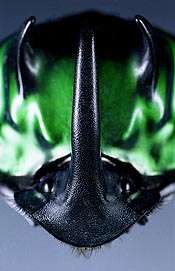Sexual Encounters of the Third Kind: Darwin's Beetles Still Producing Surprises

(PhysOrg.com) -- On the eve of Charles Darwin’s 200th birthday, researchers at the University of New Mexico and University of Montana report a new twist in sexual selection theory - the realm of evolutionary science that Darwin founded alongside his more generally known theory of natural selection. This news, which appears in the February 6th issue of Science Magazine, is particularly propitious because the discovery was made during studies of some of the same species that Darwin used to develop his ideas.
As part of National Science Foundation-funded research on the evolution of male dimorphism in insects, biology professors J. Mark Rowland, UNM, and Douglas J. Emlen, UM, were surprised to find that many species of beetles are capable of producing not only two, but three different types of males.
The sex lives of animals is known to be complicated business. Where competition in mating is particularly intense, many kinds of animals produce enlarged weapons that function in male combat and utilize alternative tactics in deploying them. Such exaggerated structures include horns in dinosaurs and deer, and tusks in elephants and walrus.
"Elaborate male weapons are also known to occur in many types of insects. Now it appears, as the research of Rowland and Emlen illustrates, that male weaponry and alternative mating tactics can be much more complex in the lives of beetles than previously imagined.
“We discovered a novel mating system in which the individual males of various species of beetles have the capacity to express one of three alternative morphologies,” said Rowland. “In many dung beetles , smaller males are unlikely to prevail in direct contests with alpha males. These beta males develop disproportionally smaller horns and employ alternative, less aggressive, reproductive tactics.
"The trimorphic species reported here have alpha, beta and gamma (completely hornless) male - three qualitatively distinct forms. A mating strategy with three such tactics implies considerable complexity, but may actually involve operational rules reminiscent of the old rock, paper, scissors game.”
The study initially discovered male trimorphism in dung beetles. Once recognized, the research was expanded and trimorphism was found in other families of beetles as well, and in other weapon systems - which include head horns in dung beetles, mandibles in stag beetles and ventral spines in weevils.
An interesting feature in these trimorphic species is that one of the three male forms was always female-like in morphology. These gamma males may thus employ a tactical deception to evade combat and earn sexual encounters.
Another twist to the story is that trimorphism is also known to exist in other animals - although it is extremely rare - and in these species the three different male forms are determined by inheritance of different alleles.
However, male trimorphism in beetles appears to be facultative in nature. That is, the different forms of males are expressed by individuals not according to the inheritance of particular genes, but according to the specific environmental conditions that they encounter.
“This likely means that facultative trimorphism operates by new and very different evolutionary rules than do ‘genetic’ trimorphisms - the latter of which have been intensively studied because of the insights they have provided about sexual selection,” said Rowland.
Provided by University of New Mexico
















